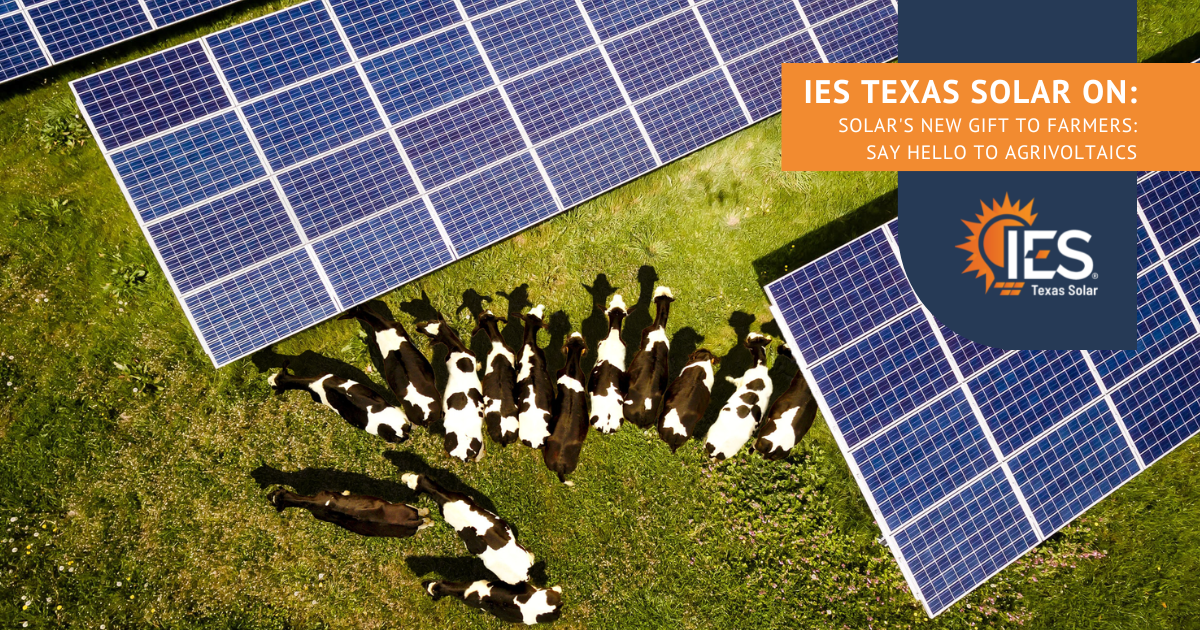
Time to read: 4 minutes
October 27, 2022
Agrivoltaics is the new solar superpower taking the farming world by storm, and with the newest Inflation Reduction Act, utility-scale arrays will soon cover a large portion of land. The term agrovoltaics has only been recently coined, although the technique of combining agriculture with solar energy has been around since the late 1900’s. Read along in our blog to learn more about agrivoltaics and what they mean for farmers.
What are agrivoltaics?
Agrivoltaics is the term used for the use of solar to generate power as well as promoting agriculture. What does this mean? Agrivoltaics has become a game changer for many farmers, and has helped with their livestock, crops, and energy usage and generation. For many farmers, the use of agrivoltaics has made their hand harvested-crops more successful and has helped their livestock stay cooler and less stressed. In an article by the Washington Post, we learn that some crops had a higher production rate due to the solar arrays above them, such as tomatoes. They also noticed that jalapenos were 167% more water efficient.
How does this work?
Although it may seem that solar panels are in fact a superpower, the reason that solar arrays are so efficient is due to how farmers and landowners have learned to use them, in a way that works for them. Brad Heins, a professor of animal science from the University of Minnesota, explains one of the unique and interesting example uses of solar for cattle. Heins and his colleagues had a problem: the grazing cows were grazing in high temperatures. When the cows are hot, they become stressed which leads to low milk production. A well known solution to this problem is to put the cows inside of a barn with fans. However, Heins decided to try something different. Heins raised the solar panels up six feet high, tall enough for the cows to walk and graze under. The cows began grazing under the shade and Heins’ and his colleagues’ studies found that the cows became less stressed. This is one of many uses that agrovoltaics gives to farmers.
Agrivoltaics history
Agrivoltaics has a long history, and the modern use of them combines old and new practices. Japan was one of the first countries to explore agrivoltaics in 2004, and by 2019 they had over a thousand agrivoltaic farms. The idea then spread across Asia and Europe and by 2011 Austria, Italy, France, and Germany had agrivoltaic farms as well. Now, they are booming in America.
Agrivoltaics in America
Agrivoltaics might seem like a new idea to the United States, but the idea has been around in other countries for much longer. It is a solar superpower that has been studied recently and used by farmers in the United States to help their crops, livestock, and help their income as well. Not only does it help the crops and helps keep cattle cool- solar arrays help farmers save money while creating energy and power. Currently, there are several studies of agrivoltaics being conducted in Colorado, such as the research being done in Colorado State University. They are also being researched at the University of Arizona, you can read more about the research of agrivoltaics here: https://www.coagrivoltaic.org/agrivoltaics-101.
Critics
Although agrivoltaics has been helpful for farmers with crops and finances, there are many critics that are focusing on things such as access to the soil being prevented due to solar arrays and conspiracies about “alleged” negative health impacts. Some towns also worry that the aesthetic may not go with the “rural character” of their communities. This is where someone like Professor Brad Heins comes in to try and find a solution and compromise for such critics.
What does Brad Heins have to say?
Professor Brad Heins is the lead researcher for agrivoltaics for the University of Minnesota. In an article by the Washington Post, Professor Heins says: “Twelve years ago, when I started here, I never imagined I’d be doing renewable energy”. He then proceeds to say: “But the thing is, farming is very energy intensive”. Professor Heins is a professor of animal science and focuses on growing technology and methods to grow synergies between energy production and agriculture. For Professor Heins, agrivoltaics means not just thriving crops, but cool cows and income as well for farms and farmers. With the data showing how crops flourish, and how it can keep cattle cool without going to expensive lengths, agrivoltaics and farming go hand in hand.
If you are considering switching to solar for your home or business, reach out to us by going to our website, iestxsolar.com, or by giving us a call at (855) 447-6527.
Sources:
https://www.washingtonpost.com/business/energy/throwing-shade-is-solar-energys-new-superpower/2022/10/02/f14ed070-4252-11ed-be17-89cbe6b8c0a5_story.html
https://energyindustryreview.com/analysis/agrivoltaic-systems-a-promising-experience/
https://www.coagrivoltaic.org/agrivoltaics-101